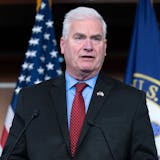Mining has been a part of Minnesota's landscape for more than 130 years. Despite the assertions in a recent commentary ("We must stop the political do-over," Jan. 30), in more than a century of mining history in our state, we have always managed the delicate balance between protecting our environment and our ongoing need for the mineral resources available in the ground below.
We all agree: Minnesotans need to stay engaged in the open, thorough and transparent process in deciding whether to permit the Twin Metals copper-nickel underground mine in northeastern Minnesota, as well as projects proposed by other companies that will come in the future.
There is one other point we agree on: We love and cherish the Boundary Waters Canoe Area Wilderness and would never put its pristine waters, rough trails or crisp air at risk. We live, work and play Up North — and believe that it's possible to protect that precious resource and deploy modern mining technology and engineering to operate a mine that creates hundreds of long-term, high-paying, skilled jobs. We have strong laws and regulations in place and should use a rational, science-based and public process to explore the potential impact of a mine.
It is because of these strong laws and regulations that Minnesota has found the balance over our 130-year history. Twin Metals understands that it must meet and exceed these strong environmental regulations as it looks toward beginning the regulatory process in the near future.
That's where we are now, in February 2019: awaiting Twin Metals' filing later this year of a comprehensive mine plan of operation, which will for the first time present in detail what is being proposed. It will be a plan based on 21st century technology to ensure a mine that is safe for its workers and for its surroundings and that meets or exceeds all standards. That is the plan that reasoned, objective heads will assess closely over a yearslong environmental, social and economic review process under state regulations and the National Environmental Policy Act — a process open to everyone.
The stakes are too high to do otherwise, which all the supporters of the Twin Metals initiative recognize and accept. We have said that if they can't meet the strictest environmental and workplace standards, they will not proceed. And, if they demonstrate that they can and do meet all standards, the project should move forward.
One of the details that we know their plans will include, for example, is that they'll move tailings to a lined, state-of-the-art holding facility away from the Twin Metals site, within a different watershed from the one serving the Boundary Waters. That's one significant indication of their commitment to protect the Boundary Waters and the environment.
Our green economy depends on mining companies like the recently permitted PolyMet project, Twin Metals and the other companies with significant mineral resources in Minnesota. The copper from mines like Twin Metals is essential to the manufacturing of wind turbines, electric vehicles, solar panels — and even the cellphones and laptops upon which you are likely reading this article. The simple fact is, it's not only the Iron Range economy relying on these mine projects; it's our entire state.



